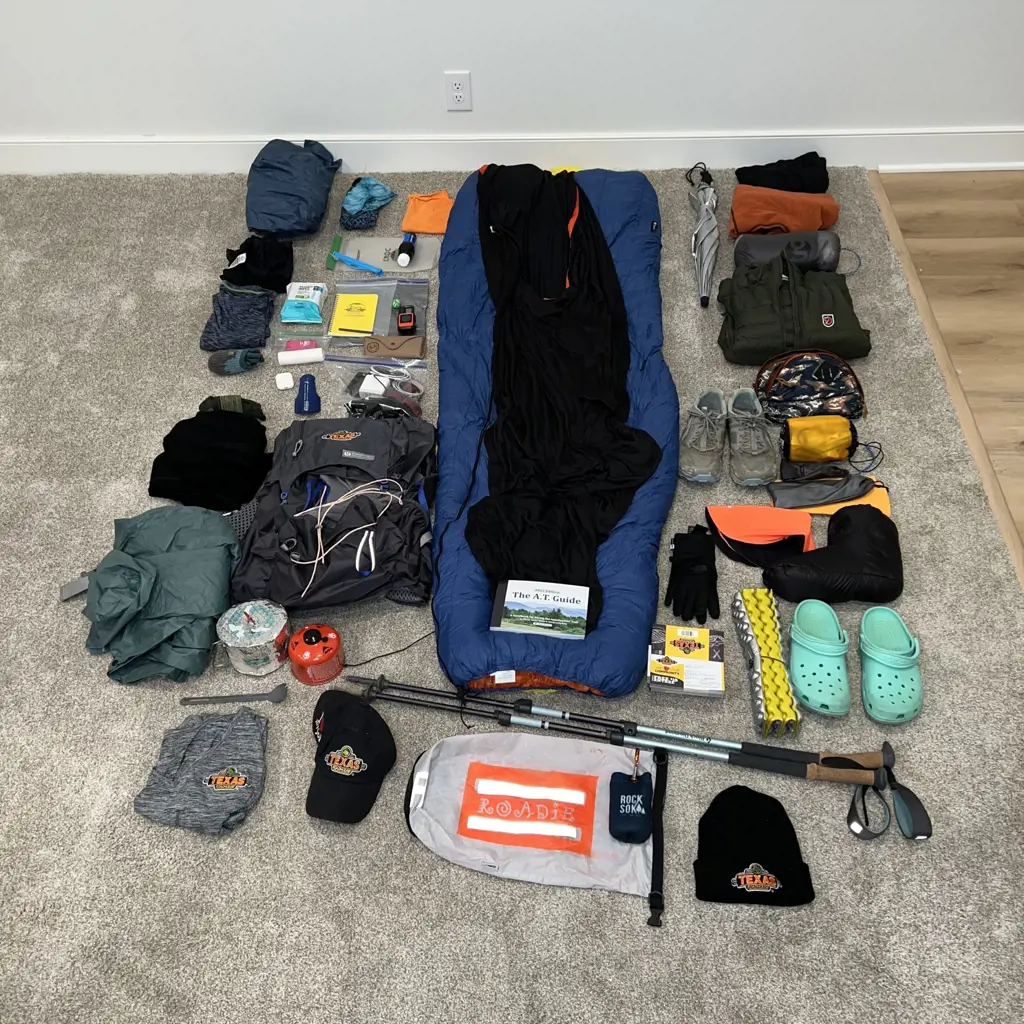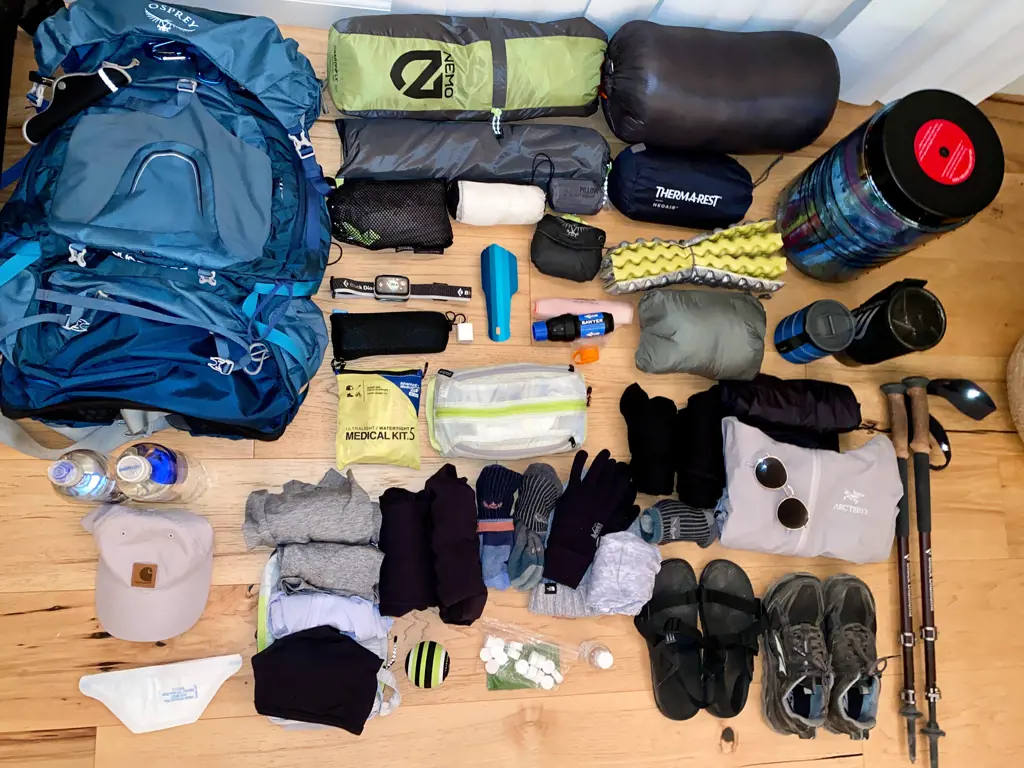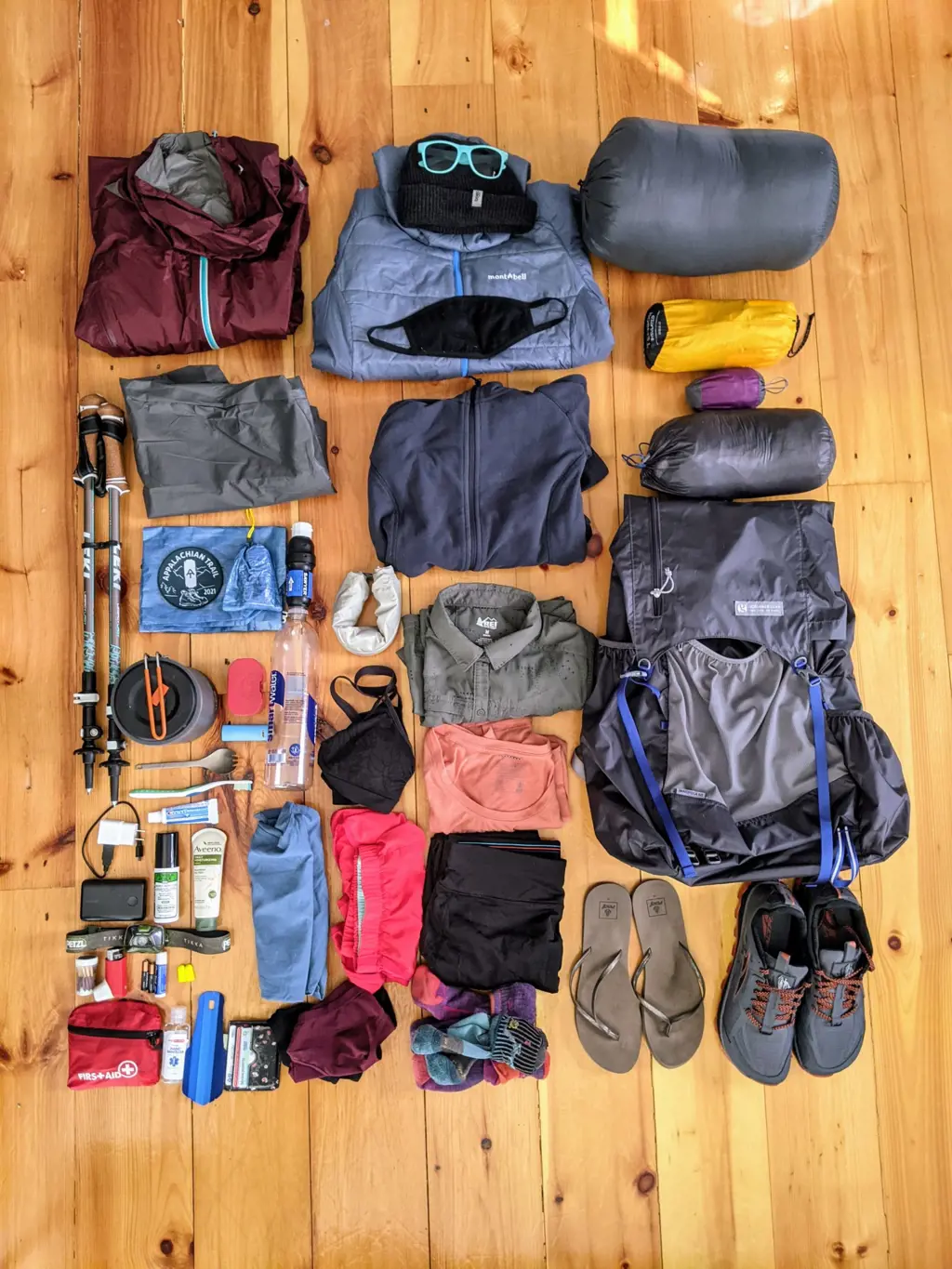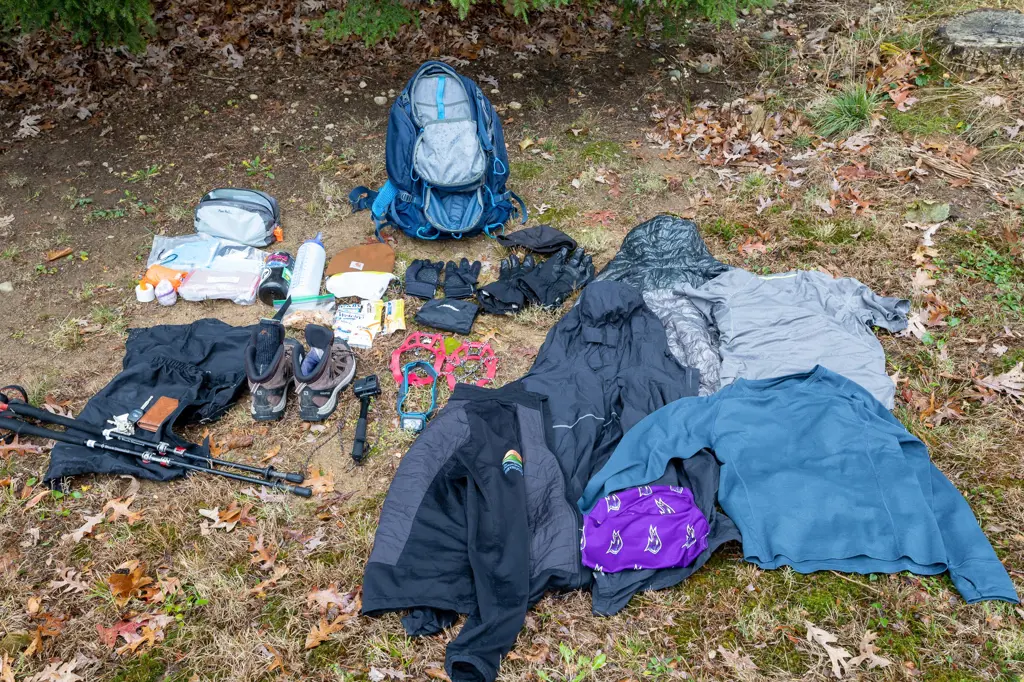
Are you itching to lace up your boots and hit the trails of the Appalachian Trail? Before you embark on this epic hiking adventure, it's crucial to pack smart and light. With so many gear choices and conflicting advice out there, it can be overwhelming to know what essentials to bring and what to leave behind. Fear not - this ultimate guide is here to help you navigate the packing process, ensuring you have everything you need to conquer the Appalachian Trail with ease. From choosing the right backpack to packing the perfect sleeping bag, we've got you covered. So grab a pen and paper, and let's dive into this packing extravaganza!
| Characteristics | Values |
|---|---|
| Clothing | - Moisture-wicking clothing - Insulating layer - Rain jacket - Hat and gloves |
| Footwear | - Hiking boots or shoes - Extra pairs of socks |
| Backpack | - Lightweight and durable - Adjustable straps - Hip belt - Multiple compartments |
| Sleeping Bag | - Lightweight and compact - Suitable for expected temperatures - Compression sack |
| Tent | - Lightweight and waterproof - Easy to set up and take down - Suitable for expected weather conditions |
| Food and Water | - Lightweight and high-calorie snacks - Water bottles or hydration pack - Water filter or purification tablets |
| Navigation | - Detailed maps of the trail - Compass - GPS device or smartphone with trail maps and apps |
| First Aid Kit | - Bandages and adhesive tape - Antiseptic wipes - Pain relievers - Insect repellent |
| Miscellaneous | - Sunscreen - Bug spray - Pocket knife - Headlamp or flashlight - Trekking poles |
What You'll Learn
- What are the essential items to pack when hiking the Appalachian Trail?
- How should I pack my backpack to ensure maximum comfort and efficiency while hiking the Appalachian Trail?
- Are there any specific clothing or gear recommendations for hiking the Appalachian Trail?
- What food and water provisions should I pack for a long-distance hike on the Appalachian Trail?
- Are there any safety precautions or emergency supplies that I should include in my backpack when hiking the Appalachian Trail?

What are the essential items to pack when hiking the Appalachian Trail?

When embarking on a hike along the Appalachian Trail, it is crucial to pack the essential items to ensure a safe and enjoyable journey. The Appalachian Trail runs for approximately 2,190 miles through the eastern part of the United States, crossing 14 states. This expansive trail offers breathtaking views, diverse wildlife, and challenging terrain, so being well-prepared is key. To make the most of your experience, here are some essential items you should pack when hiking the Appalachian Trail.
- Backpack: Invest in a backpack specifically designed for long-distance hiking. Look for one with a capacity of 50-65 liters, as this will allow you to comfortably carry all your gear and supplies.
- Tent: A lightweight and durable tent is necessary for shelter along the trail. Look for one that is easy to set up and has good weather protection. Consider the number of people hiking with you to determine the appropriate size.
- Sleeping Bag and Sleeping Pad: Opt for a sleeping bag with a temperature rating suitable for the expected weather conditions. Additionally, a sleeping pad provides insulation from the ground and adds an extra layer of comfort.
- Food and Water: Plan your meals carefully, as food availability can be limited along the trail. Pack lightweight, high-energy foods like nuts, dried fruits, and dehydrated meals. It is also essential to carry a water filter or purification system to ensure a safe drinking water supply.
- Clothing: Layering is critical to adapt to changing weather conditions. Pack moisture-wicking base layers, insulating mid-layers, and a waterproof, breathable outer layer. Don't forget to bring extra socks, a hat, and gloves for added protection.
- Footwear: Invest in a good pair of hiking boots or trail shoes that provide ankle support and have a rugged sole for traction. Make sure to break them in before hitting the trail to avoid blisters and discomfort.
- Navigation Tools: Carry a detailed map or a guidebook specific to the Appalachian Trail, along with a compass or a GPS device. These tools will help you navigate through the extensive trail and locate water sources, shelters, and campsites.
- First Aid Kit: Accidents can happen while hiking, so having a well-stocked first aid kit is crucial. Pack essentials such as bandages, antiseptic ointment, pain relievers, blister treatments, and any personal medication.
- Hygiene Items: Maintaining hygiene while hiking is essential for both personal comfort and health. Pack items like a small towel, biodegradable soap, hand sanitizer, toilet paper, and a trowel for burying human waste.
- Miscellaneous Items: Other essential items include a headlamp with spare batteries, a multi-tool, a whistle for emergencies, sunscreen, insect repellent, and a lightweight stove for cooking meals.
Remember, the key to a successful hike along the Appalachian Trail is to carry only what you need. Keeping your backpack as lightweight as possible will ensure you have the endurance and mobility to tackle the challenging terrain. Before setting off, it is also advisable to check the weather forecast, learn about any trail closures or restrictions, and inform someone of your hiking plans for safety purposes. With the right equipment and preparation, hiking the Appalachian Trail will be an incredible adventure that will leave you with lasting memories.
Essential Items to Pack for Bhutan: Your Ultimate Travel Checklist
You may want to see also

How should I pack my backpack to ensure maximum comfort and efficiency while hiking the Appalachian Trail?

Heading: How to pack your backpack for maximum comfort and efficiency while hiking the Appalachian Trail
Introduction:
Hiking the Appalachian Trail can be a challenging yet rewarding experience. One key aspect that can greatly impact your overall comfort and efficiency during your hike is how well you pack your backpack. In this article, we will discuss some tips and tricks that can help you pack your backpack effectively to ensure maximum comfort and efficiency throughout your journey.
Start with a lightweight backpack:
When choosing a backpack for your Appalachian Trail hike, select one that is lightweight yet durable. A heavy backpack can quickly become overwhelming and can lead to discomfort and fatigue. Look for a backpack that is specifically designed for long-distance hiking, with features such as a supportive hip belt and adjustable straps.
Organize your gear:
Before you start packing, lay out all your gear and categorize them into different groups such as clothing, shelter, cooking, and personal items. This organization will help you assess the amount of gear you have and ensure that you don't forget anything important.
Utilize compression sacks:
Compression sacks are a hiker's best friend when it comes to saving space inside the backpack. These sacks allow you to compress items such as sleeping bags, clothes, and jackets, reducing their overall volume. By using compression sacks, you can create more space for other essential items while keeping your backpack compact and balanced.
Follow the weight distribution principles:
Proper weight distribution plays a crucial role in maintaining balance and comfort while hiking. Place heavier items closer to your back, towards the bottom of the backpack. This lowers the center of gravity and prevents the backpack from sagging backward. Lighter items, such as clothing and sleeping pads, can be placed towards the top and sides. Additionally, try to keep the weight evenly distributed on both sides of the backpack to avoid strain on one side.
Accessible essentials:
Store frequently needed items such as maps, snacks, and water bottles in easily accessible compartments or pockets. This eliminates the need to unpack your entire backpack whenever you need something quickly. It is also helpful to have a small daypack or fanny pack to carry essentials you might need during short breaks or while exploring side trails.
Be mindful of weight:
Pay close attention to the weight of every item you pack. Consider the necessity of each item and opt for lightweight alternatives whenever possible. Every ounce saved will make a difference over the course of a long-distance hike like the Appalachian Trail.
By following these packing tips, you can ensure maximum comfort and efficiency while hiking the Appalachian Trail. Organizing your gear, utilizing compression sacks, and distributing weight properly will help you maintain balance and prevent discomfort. Remember to keep frequently needed items easily accessible and always be conscious of the weight you carry. Happy hiking!
Essential Items to Pack for Brain Surgery: A Comprehensive Guide
You may want to see also

Are there any specific clothing or gear recommendations for hiking the Appalachian Trail?

When planning a hike on the Appalachian Trail, it is crucial to consider the specific clothing and gear recommendations to ensure a safe and comfortable experience. The trail spans over 2,190 miles and traverses varied terrains and weather conditions, making proper gear selection essential. This article will guide you through the necessary clothing and gear needed for a successful Appalachian Trail hike.
Clothing Recommendations:
- Layering System: The Appalachian Trail exposes hikers to a wide range of temperatures, especially on higher elevations. It is recommended to use a layering system to easily adjust to changing weather conditions. This typically includes a base layer (moisture-wicking fabric), a mid-layer (fleece or down jacket for insulation), and an outer layer (waterproof and breathable jacket).
- Moisture-Wicking Clothing: Hiking involves physical exertion, which can cause excessive sweating. Wearing moisture-wicking clothing, such as polyester or merino wool, helps wick away sweat from the body, keeping you dry and comfortable. Avoid cotton clothing as it retains moisture and dries slowly, increasing the risk of hypothermia.
- Quick-Drying Pants: Opt for lightweight pants made of nylon or polyester that dry quickly. These pants will prevent chafing, protect your legs from brush and insects, and provide good ventilation.
- Proper Footwear: Invest in a pair of high-quality hiking boots or trail running shoes that provide good ankle support, traction, and comfort. Choose footwear suited to your hiking style and consider breaking them in before the hike to avoid blisters and discomfort.
Gear Recommendations:
- Backpack: A comfortable and durable backpack is crucial for carrying your gear and supplies. Look for a backpack with a capacity of 50-65 liters, adjustable straps, a padded hip belt, and multiple compartments for organization.
- Sleeping Bag: Choose a lightweight sleeping bag that provides adequate insulation for cold nights. The temperature rating of the sleeping bag should match the expected weather conditions on the trail.
- Tent: A reliable and lightweight tent is essential for shelter along the trail. Look for a tent with good weather resistance, easy setup, and sufficient space for your needs.
- Water Filtration System: The Appalachian Trail offers numerous water sources, but it is important to filter or purify the water before consumption. Invest in a reliable water filtration system to prevent waterborne illnesses.
- Trekking Poles: Trekking poles provide stability, reduce strain on your knees, and improve balance while hiking. These poles are especially helpful during steep ascents and descents, and when crossing rocky terrain.
- Navigation Tools: Carry a map, compass, or GPS device to navigate the trail. It is important to be prepared and know your location at all times.
- First Aid Kit: A well-stocked first aid kit is essential for treating minor injuries and emergencies on the trail. Include essentials such as bandages, antiseptic wipes, pain medication, and any personal medications.
- Food Storage: To protect your food from animals, carry a bear-resistant canister or hang your food in a bear bag at night. This reduces the risk of attracting wildlife to your camping area.
It is important to note that the Appalachian Trail can be physically demanding, and hikers should be prepared mentally and physically. Train adequately before attempting the trail and consult experienced hikers or online forums for additional advice. By following these clothing and gear recommendations, hikers can enhance their safety, comfort, and overall experience on the Appalachian Trail.
Essential Items to Pack for Your Trip to Houston
You may want to see also

What food and water provisions should I pack for a long-distance hike on the Appalachian Trail?

Undertaking a long-distance hike on the Appalachian Trail requires careful planning and preparation, especially when it comes to food and water provisions. As you venture into the wilderness, it's important to ensure you have enough sustenance to fuel your body and remain hydrated along the journey. In this article, we will discuss the recommended food and water provisions for a long-distance hike on the Appalachian Trail, drawing upon scientific research, experienced hikers' insights, and step-by-step guidelines.
Calculate your caloric needs:
Before embarking on a long-distance hike on the Appalachian Trail, it is crucial to determine your daily caloric needs. This can vary depending on factors such as your weight, age, sex, and activity level. It's generally recommended to consume around 3,000-5,000 calories per day on a long-distance hike. This high-calorie intake is necessary to sustain the energy levels required for the demanding physical activity.
Pack lightweight, high-energy foods:
When selecting food for your hike, prioritize lightweight, high-energy options. Dense calorie sources, such as nuts, seeds, and dried fruits, are excellent choices as they provide a significant amount of energy in a small package. Other lightweight options include energy bars, trail mix, dehydrated meals, and peanut butter. Aim for a combination of proteins, fats, and carbohydrates to meet your nutritional requirements.
Consider nutrition and taste:
While it's important to prioritize high-energy foods, it's also crucial to select options that provide a balanced nutritional profile. Include foods that are rich in vitamins, minerals, and fiber, such as dried vegetables and fruits. Additionally, consider packing some treats or comfort foods that can boost morale and make the hiking experience more enjoyable.
Pack for all meals and potential delays:
When planning your food provisions, account for all meals throughout your hike. It's wise to pack for an extra day or two in case of unforeseen circumstances or delays. Be mindful of any dietary restrictions or allergies and choose food items accordingly.
Ensure an adequate water supply:
Proper hydration is essential during a long-distance hike. The Appalachian Trail provides several water sources along the way, but it's essential to carry enough water to last between these points. A good rule of thumb is to carry at least two liters of water at all times. Consider using a water filtration system to treat water from natural sources and reduce the weight of carrying large quantities.
Snacks and electrolyte replenishment:
In addition to meals, pack plenty of snacks to sustain your energy levels throughout the hike. Energy bars, trail mix, and jerky are convenient options. Furthermore, it's important to replenish electrolytes lost through sweat. Carry electrolyte tablets, powdered sports drink mixes, or electrolyte-rich food options, such as coconut water or bananas.
In conclusion, when preparing for a long-distance hike on the Appalachian Trail, efficient meal planning and proper hydration are paramount. Pack lightweight, high-energy foods that meet your daily caloric needs and provide a balanced nutritional profile. Consider including treats and comfort foods to maintain morale. Ensure an adequate water supply and have a system in place to treat water from natural sources. By applying these recommendations, your food and water provisions will support your physical performance and make your hiking experience more enjoyable.
Essential Items to Pack for Introducktion: A Comprehensive Guide
You may want to see also

Are there any safety precautions or emergency supplies that I should include in my backpack when hiking the Appalachian Trail?

Hiking the Appalachian Trail can be an exhilarating and rewarding adventure, but it is important to be prepared for any potential dangers or emergencies that may arise. While the trail offers stunning views and a chance to connect with nature, it is also a rugged and challenging environment that can pose risks to even the most experienced hikers. To ensure your safety on the Appalachian Trail, here are some essential safety precautions and emergency supplies that should be included in your backpack.
- Navigation tools: The Appalachian Trail spans over 2,000 miles and can sometimes be challenging to navigate, especially in areas with limited signposts or trail markers. Ensure you have a reliable map, compass, and/or GPS device to help you stay on track and prevent getting lost.
- Communication devices: In case of an emergency, it is crucial to have a means of communication with the outside world. Carry a fully charged cell phone, but be aware that there may not always be reception along the trail. Consider investing in a personal locator beacon (PLB) or satellite messenger device that can send out distress signals even in remote areas.
- First aid kit: Accidents can happen, and having a well-stocked first aid kit is essential for dealing with minor injuries and medical issues. Your kit should include items such as bandages, adhesive tape, disinfecting wipes, pain relievers, blister treatment, insect repellent, and any personal medications you may require.
- Emergency shelter: While most hikers plan to stay in designated shelters or campsites along the Appalachian Trail, having an emergency shelter is crucial in case you cannot reach those locations or encounter unexpected weather conditions. Consider carrying a lightweight and compact emergency bivy or tarp that can provide protection from rain, wind, and cold temperatures.
- Extra food and water: It is essential to carry a sufficient supply of food and water to sustain yourself between resupply points. The Appalachian Trail passes through various remote areas where access to clean water may be limited. Carry a water filter or purifier to ensure a safe supply of drinking water. Pack lightweight, high-energy foods that are easy to prepare and provide sustenance.
- Proper clothing and footwear: Dressing appropriately for the weather and trail conditions is essential for your safety and comfort. Layer your clothing to adapt to changing temperatures, and pack rain gear to stay dry during wet weather. Invest in a pair of sturdy and comfortable hiking boots or trail shoes that provide ankle support and good traction. Avoid cotton clothing as it retains moisture, which can lead to hypothermia in colder conditions.
- Emergency fire-starting equipment: Being able to start a fire in an emergency can provide warmth, a means of signaling for help, and a way to cook food. Carry waterproof matches or a lighter, along with fire starters such as tinder or commercially available fire-starter sticks. Practice responsible fire safety and ensure fires are only started in designated areas.
- Personal protection items: The Appalachian Trail is home to various wildlife, including bears, snakes, and insects. Carry bear spray in bear-prone areas and know how to use it effectively. Protect yourself from ticks and mosquitoes by wearing long sleeves, pants, and using insect repellent. Consider carrying a whistle to help scare off wildlife or attract attention in case of an emergency.
Remember, these are just some of the essential safety precautions and emergency supplies to consider when hiking the Appalachian Trail. It's important to do proper research, check the weather forecast, and plan accordingly before embarking on your journey. Stay informed, follow Leave No Trace principles, and always prioritize your own safety and well-being. With the right preparations, you can have a safe and enjoyable hiking experience on the Appalachian Trail.
Essential Packing Tips for a Memorable Trip to Montana
You may want to see also
Frequently asked questions
For hiking the Appalachian Trail, it's important to pack clothing that is both comfortable and functional. You'll want to have a good pair of hiking boots or trail shoes, along with moisture-wicking socks to keep your feet dry. Layering is key, so pack lightweight, breathable shirts and pants that can be easily adjusted as you warm up or cool down. Don't forget a waterproof and windproof jacket to protect you from the elements.
When camping on the Appalachian Trail, it's essential to have a high-quality backpack that fits well and can carry all your gear. Look for a lightweight, waterproof tent that sets up easily and can withstand different weather conditions. A durable sleeping bag and sleeping pad are also important for a good night's rest. Other gear to consider includes a camping stove, cookware, water purification system, and a headlamp for nighttime visibility.
The amount of food and water you should pack for a hike on the Appalachian Trail will vary depending on the length of your trip and the availability of resupply points. As a general rule, plan on carrying enough food for each day of your hike, along with some extra emergency rations. Dehydrated meals and lightweight snacks are popular choices due to their convenience and long shelf life. For water, it's recommended to carry a minimum of two liters per person, and plan your route to include water sources along the way for refilling.
In addition to clothing, camping gear, and food/water, there are several other essentials you'll want to include in your backpack for hiking the Appalachian Trail. These include a map and compass (or GPS device), a first aid kit with essential items like bandages, insect repellent, sunscreen, and any necessary medications. Other items to consider include a multi-tool, duct tape, a fire starter, a whistle, and a lightweight trowel for digging cat holes for waste disposal. It's essential to weigh your pack and keep it as light as possible to avoid unnecessary strain on your body during your hike.







